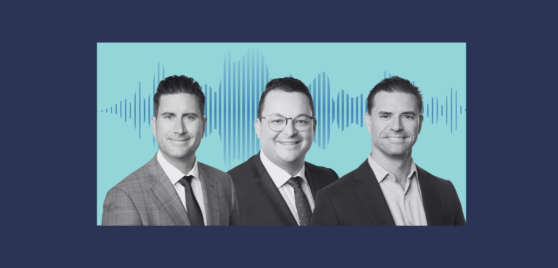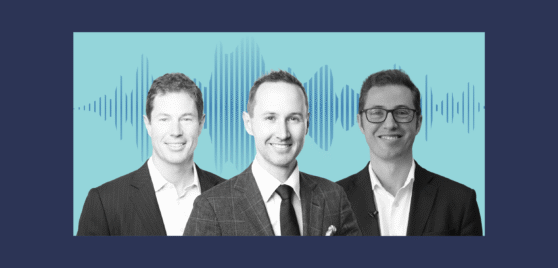Featuring Josh Freiman
LISTEN
READ
The global economy takes its lead from the US and it is an important market for many of Australia’s largest companies. IML Equity Analyst Josh Freiman has just returned from a US research trip where he gained first-hand insights into the US economy, as well as Australian companies operating in the US. He joins Natixis IM Distribution Director Carl McMinn to discuss his findings in our latest podcast.
Follow our podcast, ‘Navigating the Noise’ on Spotify, Apple or Amazon to be notified of new episodes.
 |
 |
 |
Lightly edited transcript – recorded on 24 September.
Carl McMinn: Hello and welcome to Navigating the Noise, a podcast by Natixis Investment Managers Australia, where we bring you insights from our global collective of experts to help you make better investment decisions.
I’m Carl McMinn, distribution director for Natixis Investment Managers and today I’m joined by Josh Freiman, equity analyst in the IML large cap team, who has returned from a research trip in the States.
Josh, welcome to the podcast.
Josh Freiman: Happy to be here.
Carl: Fresh back from the US. How was it?
Josh: Thanks, Carl. Yeah. Look, it was great to go to the US. I actually previously lived there for a spot during my MBA where I attended Columbia University, so it was fantastic to get back to New York City, see how it had changed and run into a couple of friends that still live over there.
Carl: But, IML, they only invest in Australian equities. So why’d you go to the States?
Josh: Yeah, good question. Despite only investing in Australian equities, look, a lot of Australian companies have overseas operations. If I think to where I went, I went and managed to see companies under my coverage, including Macquarie, Brambles, Incitec Pivot, Worley, as well as other companies that had tangential insights such as D.R. Horton with respect to building materials like James Hardie. It’s fantastic to actually get boots on the ground and to be able to see those operating businesses in different geographies because you’re not really able to get the requisite knowledge on them that you need here from doing desktop research or even from speaking to management. There’s something a little bit different that allows you to bed down your thesis when you actually visit the businesses and speak to the customers in their home markets.
Carl: Makes a lot of sense. The US economy is the world’s largest, and it has a big influence on the way our markets operate. While the US is slowing, it seems to be running pretty well. While you were there, the US Fed cut rates a sizable 50 basis points. Having spent the last week in the US, what’s the mood like on the ground, and how do you think it compares to the Australian economy?
Josh: Yeah, it’s interesting. I went all across the US so maybe I’ll reflect on where I went and then reflect on how the economy was performing there. I started in Houston before moving to San Antonio, Los Angeles, Salt Lake City, Chicago, and then New York, and it was interesting because it felt like completely different economies in completely different places. So if I reflect on my time in Houston and San Antonio, the streets were fairly empty, it wasn’t as optimistic, and it was very difficult to actually see a lot of activity going on in those markets. So walking through the downtown, there were a lot of empty shopfronts, which was pretty stark, actually. I would say it was softer than expected. When I went and visited Chicago and New York, it was the complete opposite. So hustle and bustle everywhere, there were no empty shopfronts and speaking to companies and customers there, it was clear that people were pretty optimistic irrespective of the election outcome. Now, LA and Utah, both of those places were actually somewhere in between. So I know it’s not that easy, but a little bit different depending on where we were there. I would say, though, that perhaps the market is a little bit more optimistic with respect of rate cuts now coming down and what that does for business moving forward than we’re expecting here where inflation is perhaps a little bit more sticky.
Carl: The old classic two-speed economy.
Josh: That’s right.
Carl: Staying on that note or that thread, Australia, Big Four banks’ share prices are up around 40% this year. They’re dominating the index, driving up the ASX returns. How does that compare to what’s happening in the US?
Josh: So Australian banks here, they’ve actually seen pretty stable earnings. If I think about their underlying performance, margins have stabilised now as perhaps better than expected funding costs have been offset with perhaps a little bit higher competition in the mortgage book. However, they’ve been pretty stable and impairments have been lower than expected, so minor earnings upgrades. However, when I look at their share price performance, they’ve absolutely rallied versus the index. What that really means is we’ve seen considerable multiple expansion. Now in other markets, we haven’t really seen that same level of multiple expansion.
Carl: And what about the perceived safety of Australian banks? How do you think that factors into the share prices?
Josh: Yeah, great question. So when I consider Australian banks relative to international banks and you compare them on internationally comparable CET1 ratios, which is the baseline capital ratio to check banks’ capital adequacy, you can see that the Australian banks are beyond strong relative to peers. Not only are they in the top quartile, but the Big Four Australian banks are regularly in the top 10 banks globally for capitalisation ratios. So if you’re worried about arrears and bad debts and markets falling down, the Australian banks typically are some of the safest banks for investors to invest in. And that’s underpinned as well by our Four Pillar Policy, so I think that is a big contributor to their re-rating relative to the market and relative to global banking peers.
Carl: Moving back to the States, you visited quite a few Australian companies. Let’s start with Brambles, which is quite a big holding for IML’s large cap funds. It has been a very good performer in recent times. How do you think it’s sitting at the moment, and what do you think of its prospects?
Josh: Brambles has been a fantastic holding for us recently. As they said in their recent US investor tour, which I was attending, since COVID, they’ve managed to improve the asset efficiency of their pallet pool, and they’ve managed to lower the capex requirements. And what that really does is that allows the business to generate materially higher free cashflow generation, as well as provide a materially better yield and buy back stock. When I consider what we went through on the investor day, I could see that they have many initiatives in the near and longer term that should continue to see improvements in that asset efficiency. What that really means is I believe Brambles’ management will be able to lower uncompensated losses and improve the speed of pallets moving around the market. That should, in turn, drive better revenue yield, as well as better for cash flow generation over the medium term and allow for persistent capital return for shareholders, something that we continue to look for in our large cap funds.
Carl: So more pool pallets in the pool pallet system and keeping track of them for longer.
Josh: That’s right. And actually on that point, it’s worth mentioning that management delved into their digitisation strategy. So what that really means is management are going to find a way to tag every individual pallet in the pallet pool, and they’ll be able to iron out any kinks there are where pallets remain stuck at specific clients or stuck between clients, and that should result in more pallets moving around the pool much more quickly. And if you think about that, because they can charge for each iteration of the pallet moving around the pool, that should result in better revenue prospects across the whole pool, and in turn, better free cash flow generation for the business.
Carl: Feeling sorry for all those art students out there with those makeshift coffee tables. But let’s shift to Macquarie now, another big Aussie global success story, whose share price took a hit after its recent August reporting season update. It’s bounced back, it’s trading at near-record levels. Some speculation that Macquarie may struggle to live up to its lofty valuation. What are your thoughts on Macquarie’s future prospects?
Josh: Macquarie had some near-term performance issues in terms of their BFS, or banking and financial services business, as well as MacCap, which is their traditional investment banking business. And those issues were really around a lower banking margin of higher funding costs, as well as lower capital markets activity. What that really means is fewer IPOs and fewer equity recapitalisations on the ASX and other international exchanges.
Now while that short-term volatility and operating trends has been a little bit of an issue from Macquarie earlier this year, they’ve come roaring back to the front with their AirTrunk sale. What that is, is within their MAM business, which is Macquarie Asset Management, they’ve invested in a data centre business, and they’ve managed to grow it from $3 billion valuation to $24 billion valuation. That results in performance fees being generated, which is good for the shareholder and is something we expect to continue to see given their existing business in the US, which has two additional data centre operators that are bigger than AirTrunk itself.
Carl: Let’s finish on Incitec Pivot, another large global Australian business. You had a rather interesting site visit for them.
Josh: Yeah, that’s right. So I attended the investor day for Incitec Pivot, or IPL. Now it’s worth noting that moving forward they’re going to rebrand the group to Dyno Nobel, which is their explosives business, and they’re going to look to divest their fertiliser business over the next six to 12 months. Now the investor day really focused on what their key competitive advantage is in that explosives business, as well as their product differentiation to peers and their growth aspirations, as well as their transformation program. Now the key takeaway from that is that the transformation program should result in materially better financial outcomes for the company, but there’s still a long way to go as they look to divest that fertiliser business, as well as turn around some of the plants that they have operating in existing markets.
The key part of the transformation program is really around cost out, becoming more efficient, as well as expanding into new markets, including LATAM and EMEA, so something to watch out for. I would say as well that one of the best parts of that investor trip was the ability to actually see the coalface. And what I mean by that is they actually took us to see one of the biggest copper mines in the world, the Rio Kennecott Mine. At the mine, we were able to see how the explosives plan actually produced explosives for the business and how much it was able to do so every day, which was actually in excess of what the copper mine needed. Additionally, they were able to take us to their explosives testing plant, and we were able to see the key product differentiation they have around wireless detonators, as well as emulsion distribution trucks.
Carl: Picturing you with the ACME plunger at the Rio copper mine setting off the explosives, so finish off the US trip with a boom! That’s great.
Josh: That’s right. I wanted to be the one to set it off, but when I “meep meeped”, they took the detonator away from me quickly, so maybe next time.
Carl: Understandable. Well, thank you, Josh, for coming on today, particularly so soon after you flew back from the States. And thank you, of course, to our listeners for joining us. If you enjoyed today’s episode, please click ‘Follow’ on your favorite podcast platform or the ‘bell’ icon to be notified of future episodes. And tune in again to hear more from our global collective of experts.
Although Natixis Investment Managers Australia believes that the material in this podcast is correct, no warranty of accuracy, reliability, or completeness is given, including for information provided by third parties except for liability under statute which cannot be excluded. This material is not personal advice. The material is for general information only and does not take into account your personal objectives, financial situation or needs. You should consider and consult with your professional advisor whether the information is suitable for your circumstances. The opinions expressed in the materials are those are the speakers and may not necessarily be those of Natixis Investment Managers Australia or its affiliate investment managers. Before deciding to acquire or continue to hold an investment in a fund, you should consider the information contained in the product disclosure statement in conjunction with the target market determination, TMD, available at www.stg-imlimited-staging.kinsta.cloud.
Past investment performance is not a reliable indicator of future investment performance and no guarantee of performance, return of capital, or a particular rate of return is provided. Any mention of specific company names, securities or asset classes is strictly for informational purposes only and should not be taken as a recommendation to buy, hold, or sell. Any commentary about specific securities is within the context of the investment strategy for the given portfolio. The material may not be reproduced, distributed, or published in whole or in part without the prior written consent of Natixis Investment Managers Australia.
Copyright 2024 Natixis investment Managers Australia. All rights reserved.
INVESTMENT INSIGHTS & PERFORMANCE UPDATES
Subscribe to receive IML’s regular performance updates, invitations to webinars as well as regular insights from IML’s investment team, featured in the Natixis Investment Managers Expert Collective newsletter.
IML marketing in Australia is distributed by Natixis Investment Managers, a related entity. Your subscriber details are being collected by Natixis Investment Managers Australia, on behalf of IML. Please refer to our Privacy Policy. Natixis Investment Managers Australia Pty Limited (ABN 60 088 786 289) (AFSL No. 246830) is authorised to provide financial services to wholesale clients and to provide only general financial product advice to retail clients.





